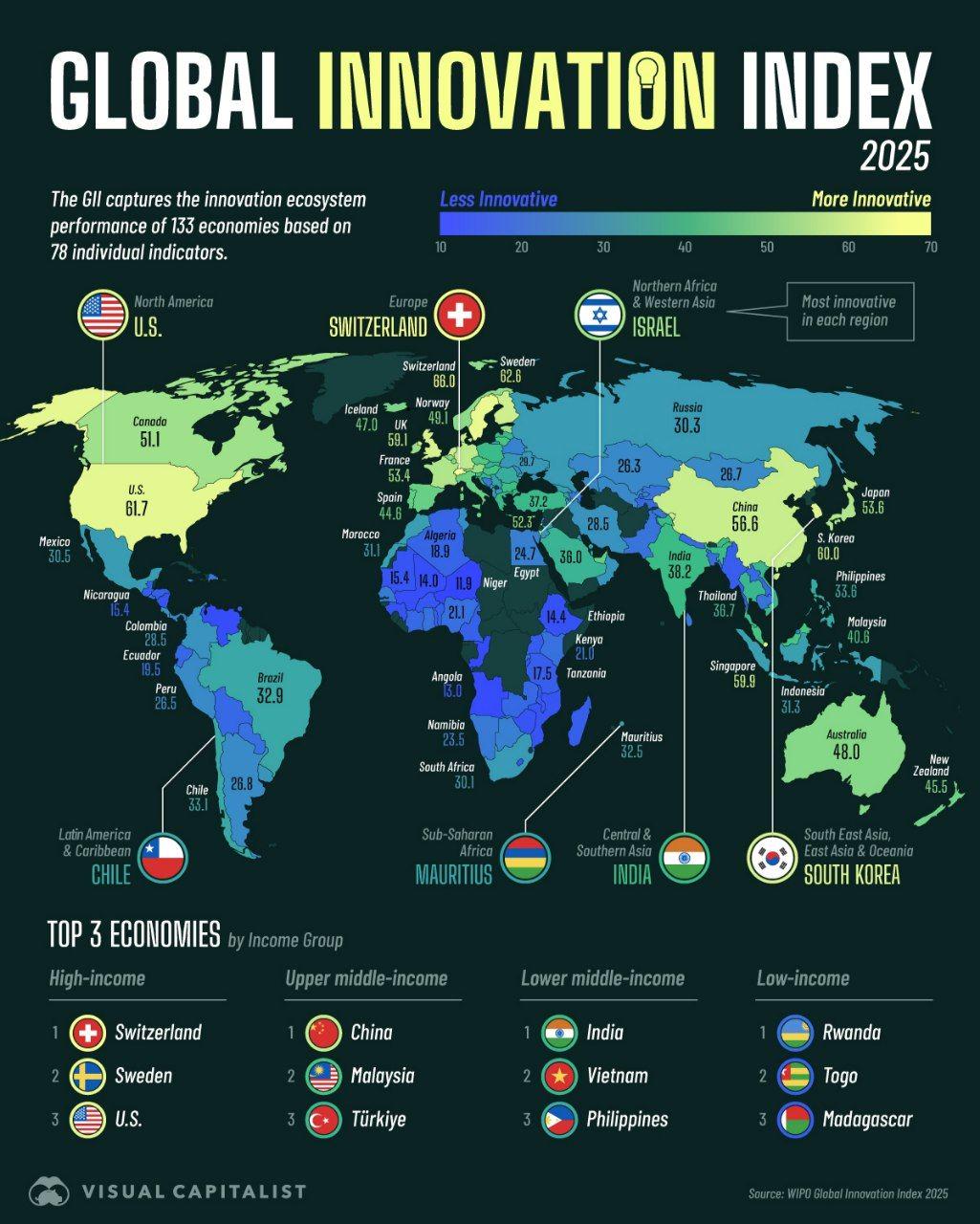Global Innovation Index in 2025 Map


David Chen
Data Visualization Specialist
David Chen is an expert in transforming complex geographic datasets into compelling visual narratives. He combines his background in computer science ...
Geographic Analysis
What This Map Shows
The "Global Innovation Index in 2025 Map" provides a visual representation of how various countries rank in terms of innovation capabilities and performance. This index is a critical tool for understanding the innovation landscape across different regions and highlights the factors contributing to economic growth and technological advancement. Innovation is not just about high-tech inventions; it encompasses a wide range of areas including education, infrastructure, and business sophistication.
Deep Dive into Global Innovation
Innovation is a key driver in today’s global economy, influencing everything from economic growth to societal well-being. The Global Innovation Index (GII) ranks countries based on various metrics that assess their ability to innovate. These metrics include aspects such as research and development (R&D), technology transfer, and the quality of human capital. Interestingly, the GII also considers the political and economic environment, which can significantly impact a country’s innovative capacity.
The GII is compiled annually by the World Intellectual Property Organization (WIPO), among others, and serves as a benchmark for governments and businesses to identify areas of improvement. For instance, countries with high GII scores typically invest heavily in education and R&D. They also have robust institutions that support innovation, such as intellectual property laws that protect the rights of inventors and entrepreneurs. Conversely, nations with lower rankings often face challenges like inadequate infrastructure or limited access to funding, which stifles creativity and innovation.
One of the most fascinating trends observed over the years is the rise of emerging economies in the innovation space. Countries such as China and India have rapidly climbed the ranks due to their focus on tech development and increased investment in education. In fact, China has made it to the top 15 of the GII rankings, demonstrating how concerted efforts in innovation can yield significant results. On the other hand, traditional powerhouses like the United States and Germany continue to lead, but they must innovate continuously to maintain their positions—an ever-evolving challenge.
Regional Analysis
When examining the map, it becomes evident that regions like North America and Western Europe dominate the rankings. For example, the United States consistently scores high due to its vast resources allocated toward R&D and a vibrant startup ecosystem, especially in Silicon Valley. Countries like Sweden and Switzerland also excel in innovation, largely due to their strong educational systems and supportive government policies.
In contrast, regions like Sub-Saharan Africa and parts of South Asia face significant hurdles. Countries such as Nigeria and India show promise, but they still grapple with infrastructure deficits and limited access to funding for innovation projects. However, it’s noteworthy that nations like Kenya are making strides in technology and mobile innovation, showcasing the potential for growth in these regions.
Interestingly, the Middle East is also witnessing a transformation. Countries such as the United Arab Emirates are investing heavily in technology and innovation hubs, aiming to diversify their economies beyond oil dependency. This shift is crucial in fostering a sustainable and innovative environment, which is reflected in their GII rankings.
Significance and Impact
The significance of the Global Innovation Index cannot be overstated. It serves as a crucial indicator of a nation’s economic health and future growth potential. As we move further into the 21st century, the ability to innovate will increasingly determine a country’s competitiveness on the global stage.
Moreover, the ongoing COVID-19 pandemic has accelerated many countries' focus on innovation, particularly in healthcare and digital technologies. The rise of remote work and telehealth services is just one example of how necessity drives innovation. As we look towards the future, understanding the GII will be essential for policymakers, educators, and business leaders alike.
In conclusion, the Global Innovation Index in 2025 map is more than just a visual representation; it offers insights into the complex web of factors influencing innovation worldwide. By analyzing these trends and data, we can identify opportunities and challenges that lie ahead, ensuring that nations remain competitive and dynamic in an increasingly interconnected world.
Visualization Details
- Published
- September 30, 2025
- Views
- 58
Comments
Loading comments...